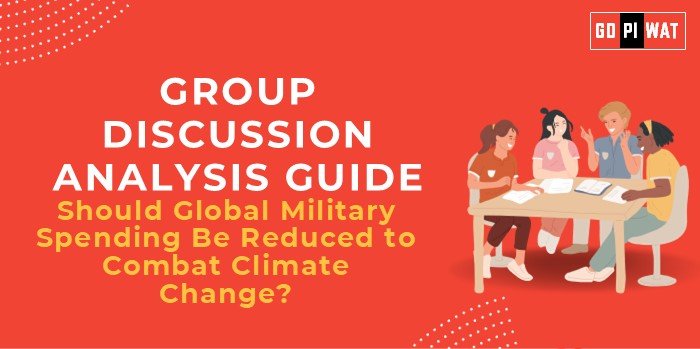📋 Group Discussion Analysis Guide: Should Global Military Spending Be Reduced to Combat Climate Change?
🌐 Introduction to the Topic
- 📌 Opening Context: Global military expenditures exceeded $2.24 trillion in 2023, while the climate crisis continues to threaten ecosystems and economies worldwide. This dilemma raises critical questions about resource allocation priorities.
- 📖 Topic Background: Military budgets have traditionally focused on national defense. However, the growing urgency of climate change has led to calls for reallocating these funds toward renewable energy, resilience-building, and climate adaptation measures.
📊 Quick Facts and Key Statistics
🌍 Global Military Spending (2023): $2.24 trillion – Higher than the GDP of Italy.
💰 Climate Finance Gap: $100 billion/year unfulfilled in pledged funds for developing nations (OECD, 2023).
🌿 Carbon Footprint of Militaries: U.S. Department of Defense emits more greenhouse gases than 140 countries (Brown University, 2023).
🏠 Climate-induced Displacement: Over 20 million people displaced annually (UNHCR, 2023).
💰 Climate Finance Gap: $100 billion/year unfulfilled in pledged funds for developing nations (OECD, 2023).
🌿 Carbon Footprint of Militaries: U.S. Department of Defense emits more greenhouse gases than 140 countries (Brown University, 2023).
🏠 Climate-induced Displacement: Over 20 million people displaced annually (UNHCR, 2023).
👥 Stakeholders and Their Roles
- 🏛️ Governments: Policy prioritization and budget allocation.
- 📈 Military-Industrial Complex: Advocates for defense spending; potential in green technology.
- 🌍 International Organizations: UN, IPCC pushing for climate action funding.
- 🌱 Citizens and Activists: Grassroots demand for climate investment.
- 💡 Private Sector: Innovation in dual-use (military and climate) technologies.
🏆 Achievements and Challenges
✨ Achievements:
- 🌐 NATO Green Defense Initiative: Investments in low-carbon military tech.
- 🌿 Climate-focused budgeting: Seen in countries like Costa Rica (no military).
⚠️ Challenges:
- ⚖️ Strong lobbying by defense contractors.
- 🌍 Security concerns: Especially in geopolitically tense regions.
- ⏳ Slow pace of international agreements: Like the Paris Accord.
🌍 Global Comparisons:
- ✔️ Success: Costa Rica redirected military budgets to education and sustainability.
- ❌ Challenge: The U.S. maintains $800 billion in military spending.
Case Studies:
- 🌿 Sweden: Defense adaptation to climate resilience.
- 🏝️ Pacific Islands: Prioritization of climate defense over traditional military.
📢 Structured Arguments for Discussion
- ✅ Supporting Stance: “Redirecting military funds to climate change would address root causes of global instability, such as resource conflicts and displacement.”
- ❌ Opposing Stance: “Military readiness cannot be compromised, as geopolitical threats like the Ukraine war persist.”
- ⚖️ Balanced Perspective: “A hybrid model emphasizing both defense and climate adaptation is crucial for long-term security.”
🧠 Effective Discussion Approaches
- 🎯 Opening Approaches:
- “With $2.24 trillion in global military spending, can we afford to ignore climate resilience investments?”
- “The carbon footprint of militaries calls into question the sustainability of current defense policies.”
- 🤝 Counter-Argument Handling:
- Point out dual-use potential (e.g., disaster response from military tech).
- Cite examples of reallocation successes (Costa Rica, EU).
📊 Strategic Analysis of Strengths and Weaknesses
- 🌟 Strengths: Dual-use potential, high visibility of climate crises.
- ⚠️ Weaknesses: Strong military-industrial lobbying.
- 📈 Opportunities: Climate tech innovation.
- ⚡ Threats: Geopolitical instability.
🎓 Connecting with B-School Applications
- 💼 Real-World Applications:
- Climate finance in public policy.
- Operations management in defense sectors.
- 📚 Sample Interview Questions:
- “What challenges arise when balancing defense and climate priorities?”
- “Can military spending be a catalyst for green innovation?”
- 💡 Insights for B-School Students:
- Develop dual-focus strategies.
- Explore roles in policy advisory or green tech innovation.


